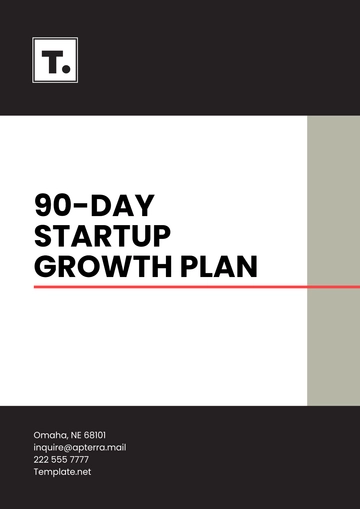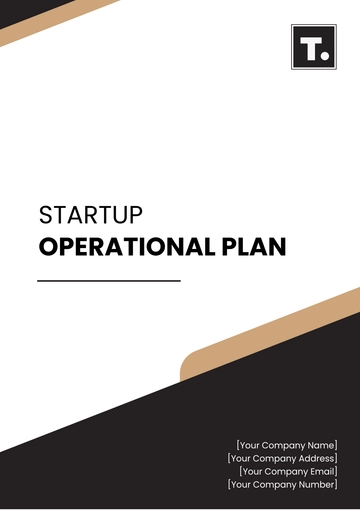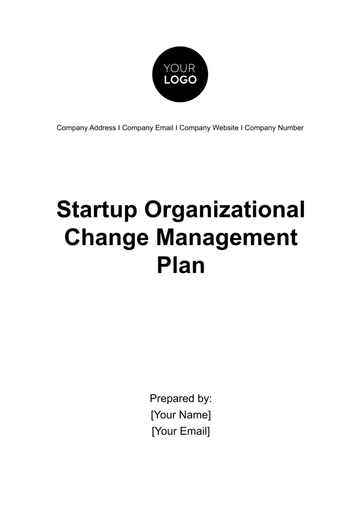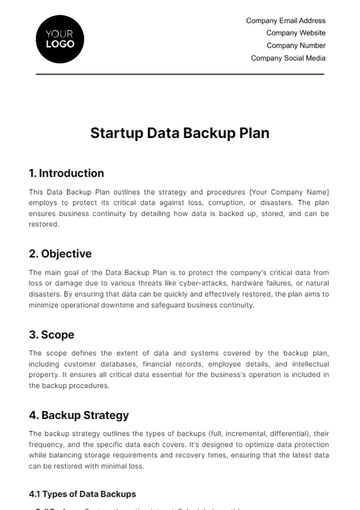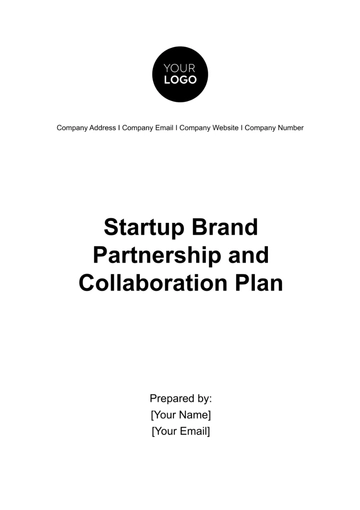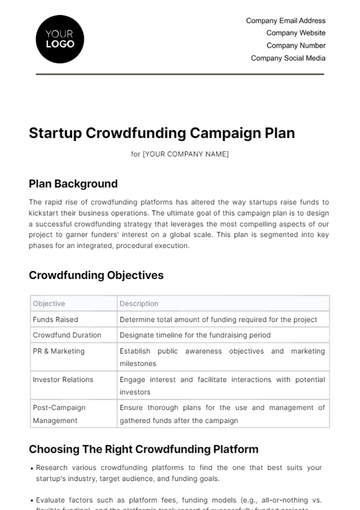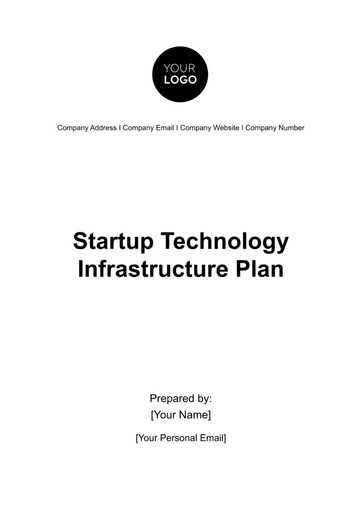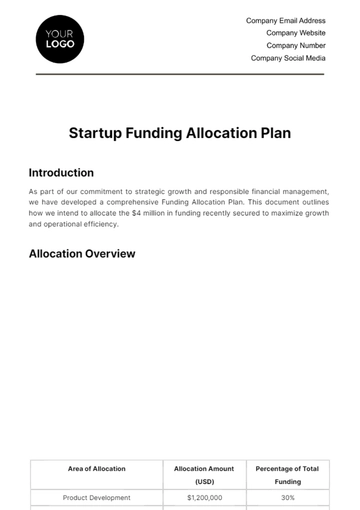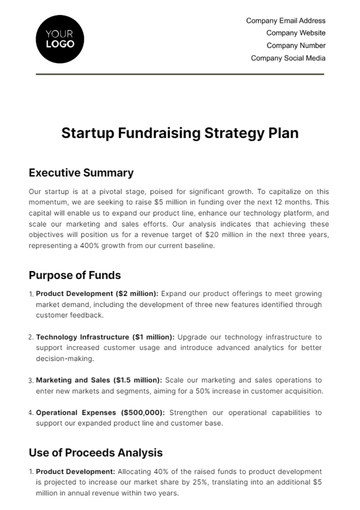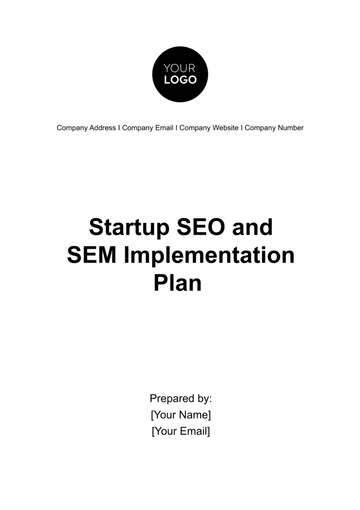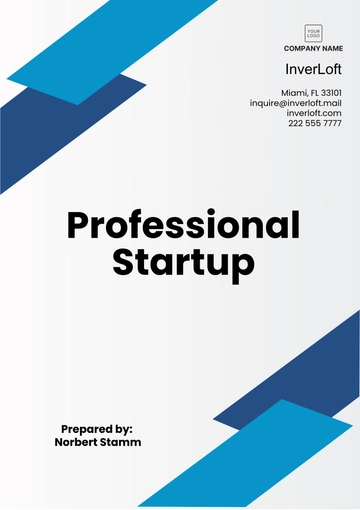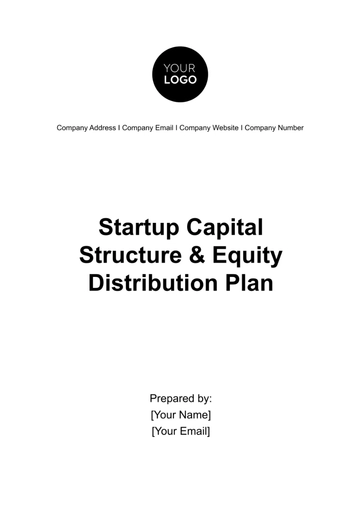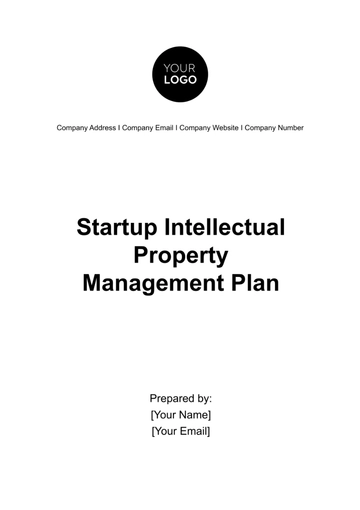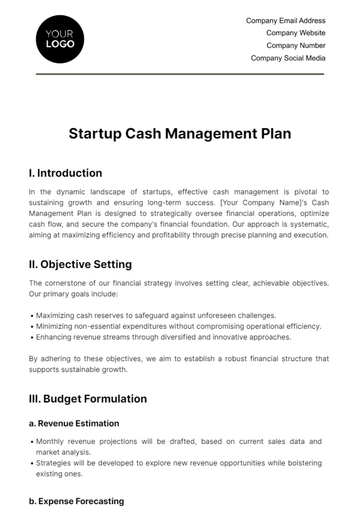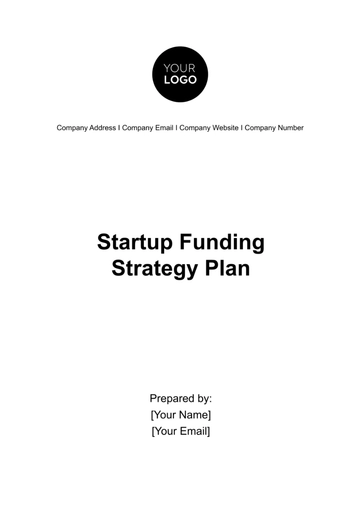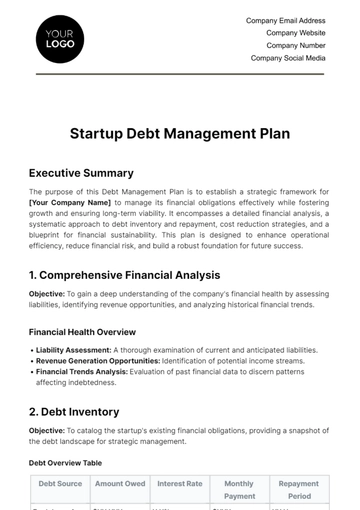Free Startup Technology Infrastructure Plan
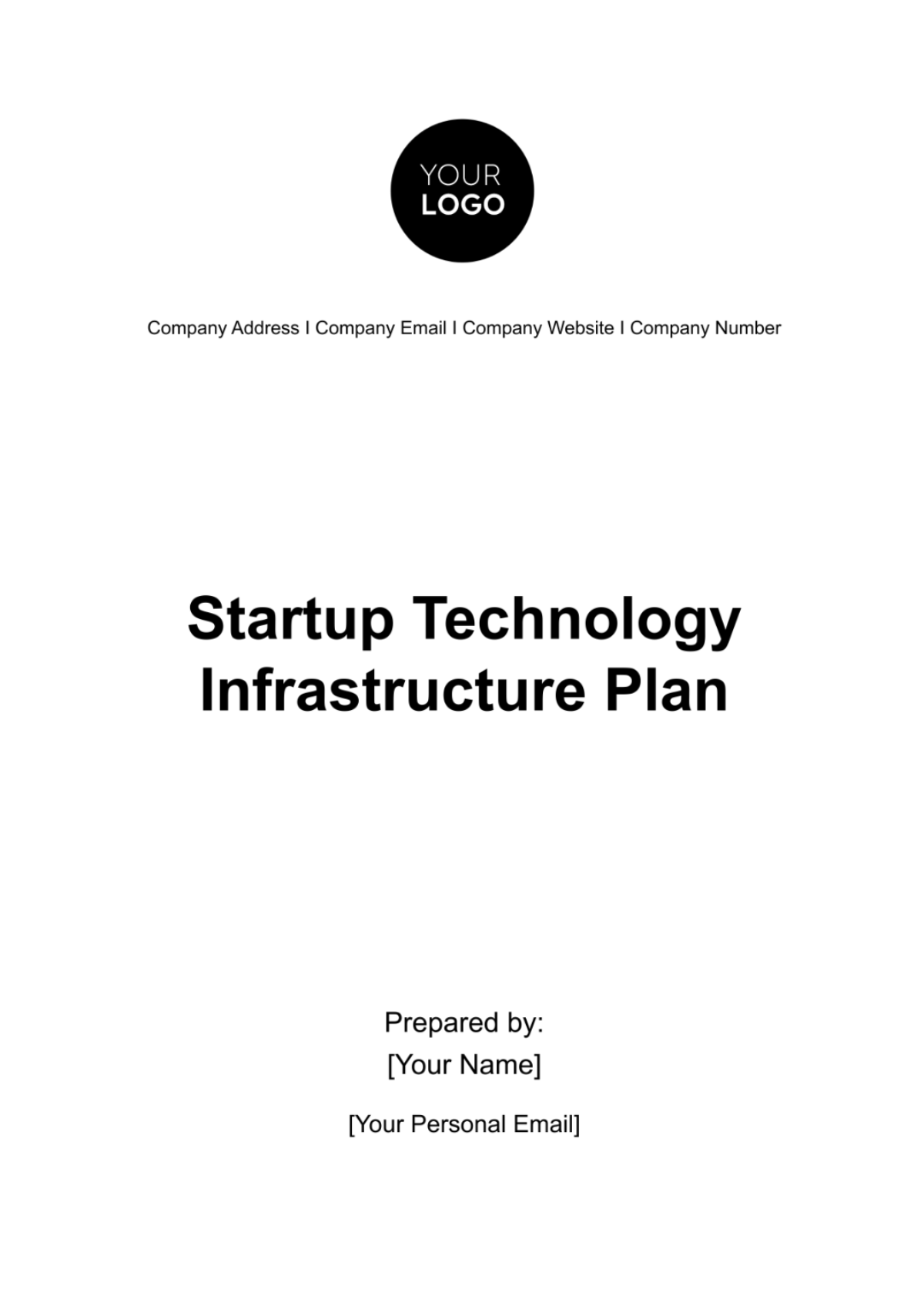
I. Introduction
In today's fast-paced business environment, having a solid technology infrastructure is paramount for the success of any startup. This Technology Infrastructure Plan outlines [Your Company Name]'s strategy for establishing a robust and scalable technology framework to support its operations and growth objectives.
II. Objectives
Scalability: Develop a technology infrastructure that can easily scale to accommodate [Your Company Name]'s growth and expansion plans without compromising performance or reliability.
Security: Implement stringent security measures to protect [Your Company Name]'s sensitive data, intellectual property, and systems from cyber threats and unauthorized access.
Efficiency: Optimize technology systems and processes to enhance operational efficiency, productivity, and cost-effectiveness across [Your Company Name]'s business functions.
Innovation: Foster a culture of innovation by leveraging cutting-edge technologies and platforms to drive product development, customer engagement, and competitive differentiation.
III. Current Technology Assessment
A. Infrastructure Inventory
In this phase, a comprehensive inventory of all existing technology assets is conducted. This includes hardware components such as servers, workstations, networking devices, and storage systems, as well as software applications, licenses, and subscriptions. Additionally, infrastructure components like data centers, cloud services, and telecommunications systems are identified and documented.
B. Performance Evaluation
A thorough evaluation of the performance and effectiveness of the current technology systems is undertaken. This involves analyzing factors such as system uptime, response times, throughput, and resource utilization. Performance metrics are gathered from monitoring tools, logs, and user feedback to assess the reliability and efficiency of the existing infrastructure.
C. Gap Analysis
A gap analysis is performed to identify discrepancies between the current technology infrastructure and [Your Company Name]'s business objectives and requirements. This involves comparing the existing capabilities and functionalities against the desired state, taking into account factors such as scalability, security, and compliance. The analysis highlights areas where improvements or enhancements are needed to bridge the gap and align the technology infrastructure with organizational goals.
D. Risk Assessment
A risk assessment is conducted to identify potential vulnerabilities, threats, and risks associated with the current technology infrastructure. This includes evaluating security vulnerabilities, data privacy concerns, regulatory compliance issues, and potential points of failure. Risk mitigation strategies are developed to address identified risks and minimize their impact on [Your Company Name]'s operations and reputation.
E. Stakeholder Consultation
Input is gathered from key stakeholders, including IT staff, department heads, and end-users, to gain insights into their experiences, challenges, and requirements related to the current technology infrastructure. Feedback and suggestions provided by stakeholders are incorporated into the assessment process to ensure that their needs and concerns are adequately addressed in the planning and implementation phases.
F. Documentation Review
All relevant documentation related to the current technology infrastructure, such as system configurations, network diagrams, security policies, and service level agreements, is reviewed and analyzed. Any discrepancies, inconsistencies, or outdated information are identified and addressed to ensure that the documentation accurately reflects the current state of the infrastructure.
By conducting a comprehensive assessment of the current technology infrastructure, [Your Company Name] can gain valuable insights into its strengths, weaknesses, and areas for improvement. This forms the basis for developing a strategic plan to enhance and optimize the technology infrastructure to better support [Your Company Name]'s business objectives and future growth.
IV. Technology Infrastructure Components
A. Hardware
The hardware component of [Your Company Name]'s technology infrastructure encompasses all physical equipment necessary for its operations. This includes servers, workstations, desktops, laptops, networking devices, storage devices, and peripheral devices. The hardware infrastructure is responsible for processing and storing data, facilitating communication, and supporting various software applications and services.
B. Software
Software forms the backbone of [Your Company Name]'s technology infrastructure, providing essential functionalities and capabilities for business operations. This includes operating systems, productivity software, collaboration tools, database management systems, enterprise resource planning (ERP) systems, customer relationship management (CRM) software, and industry-specific applications. The software infrastructure enables efficient data processing, communication, collaboration, and decision-making across the organization.
C. Networks
The network infrastructure of [Your Company Name] comprises the interconnected systems and devices that facilitate communication and data transfer within the organization. This includes local area networks (LANs), wide area networks (WANs), wireless networks, routers, switches, firewalls, and other networking components. The network infrastructure enables seamless connectivity, data sharing, and resource access among employees, departments, and locations, supporting collaboration and productivity.
D. Cloud Services
Cloud services play a critical role in [Your Company Name]'s technology infrastructure, providing scalable and flexible computing resources and services over the internet. This includes Infrastructure as a Service (IaaS), Platform as a Service (PaaS), Software as a Service (SaaS), and other cloud-based solutions. Cloud services offer benefits such as cost-efficiency, scalability, agility, and accessibility, enabling [Your Company Name] to leverage advanced technologies and innovation without the need for extensive on-premises infrastructure.
E. Cybersecurity
Cybersecurity is a paramount consideration in [Your Company Name]'s technology infrastructure, encompassing measures to protect its data, systems, and digital assets from cyber threats and unauthorized access. This includes implementing firewalls, intrusion detection and prevention systems, antivirus software, encryption technologies, multi-factor authentication, and security policies and procedures. Cybersecurity measures are essential for safeguarding sensitive information, maintaining regulatory compliance, and preserving the trust and reputation of [Your Company Name] and its stakeholders.
F. Data Management
Effective data management is essential for [Your Company Name]'s technology infrastructure, encompassing processes and practices for collecting, storing, processing, analyzing, and managing data throughout its lifecycle. This includes database management systems, data warehouses, data lakes, data governance frameworks, data quality management, and data integration solutions. Data management ensures the accuracy, reliability, availability, and security of [Your Company Name]'s data assets, supporting informed decision-making, compliance, and business intelligence initiatives.
G. Disaster Recovery and Business Continuity
Disaster recovery and business continuity are critical components of [Your Company Name]'s technology infrastructure, ensuring the resilience and availability of its systems and services in the event of unforeseen disruptions or disasters. This includes developing and implementing strategies, plans, and procedures for data backup and recovery, system redundancy, failover mechanisms, and continuity of operations. Disaster recovery and business continuity measures minimize downtime, data loss, and financial impact, enabling [Your Company Name] to maintain business continuity and recover quickly from disruptions.
V. Implementation Plan
A. Timeline
Initial Planning (Month 1-2): During this phase, [Your Company Name] will conduct detailed planning sessions to define project goals, objectives, and deliverables. Key activities include gathering requirements, defining scope, establishing timelines, and identifying resources.
Infrastructure Procurement (Month 3-4): [Your Company Name] will initiate the procurement process for hardware, software, networking equipment, and cloud services as per the defined specifications and budgetary constraints. Vendor selection, negotiations, and contract finalization will be completed during this phase.
Infrastructure Deployment (Month 5-6): The deployment phase involves setting up hardware, installing software, configuring networks, and implementing security measures according to the approved design and architecture. Testing and validation of the infrastructure components will also be conducted to ensure functionality and interoperability.
User Training and Adoption (Month 7-8): To facilitate smooth adoption and usage of the new technology infrastructure, [Your Company Name] will conduct comprehensive training sessions for employees, covering software applications, security protocols, and best practices. User feedback and support mechanisms will be established to address any issues or concerns.
Integration and Optimization (Month 9-10): Integration of disparate systems and platforms will be undertaken to ensure seamless communication and data flow across [Your Company Name]'s technology ecosystem. Optimization efforts will focus on fine-tuning performance, enhancing scalability, and improving efficiency based on feedback and usage patterns.
B. Budget
Infrastructure Investment: [Your Company Name] has allocated a budget of $X for procuring hardware, software licenses, networking equipment, and cloud services. This budget includes upfront costs as well as ongoing expenses for maintenance, support, and upgrades over the project duration.
Resource Costs: The implementation plan includes budgetary allocations for internal resources, external consultants, vendors, and service providers involved in the deployment and management of the technology infrastructure. These costs cover labor, professional fees, travel expenses, and other associated expenses.
Contingency Reserve: A contingency reserve of X% has been set aside to account for unforeseen expenses, scope changes, and project risks that may arise during the implementation phase. This reserve ensures that [Your Company Name] has sufficient financial flexibility to address any challenges or setbacks encountered during the project.
Budget Category | Allocation (USD) |
|---|---|
Infrastructure Investment | $X |
Resource Costs | $X |
Contingency Reserve | X% of Total Budget |
C. Resource Allocation
Internal Resources: [Your Company Name] will allocate dedicated internal resources, including IT personnel, project managers, and subject matter experts, to oversee and execute the implementation plan. These resources will be responsible for coordinating activities, managing vendors, and resolving issues in a timely manner.
External Consultants: In addition to internal resources, [Your Company Name] may engage external consultants or third-party vendors with specialized expertise in areas such as system integration, cybersecurity, and cloud migration. These consultants will provide technical guidance, support, and assistance to ensure the successful implementation of the technology infrastructure.
Vendor Management: [Your Company Name] will establish clear communication channels and governance structures for managing vendor relationships and performance. Regular meetings, progress reports, and service level agreements (SLAs) will be used to monitor vendor performance, resolve issues, and ensure alignment with project goals and objectives.
D. Testing and Validation
Test Plan Development: [Your Company Name] will develop a comprehensive test plan outlining testing objectives, methodologies, success criteria, and timelines for each phase of the implementation. Test scenarios and scripts will be created to validate the functionality, performance, and security of the technology infrastructure components.
Testing Execution: Rigorous testing will be conducted to validate the functionality, interoperability, and reliability of the technology infrastructure components. This includes unit testing, integration testing, system testing, user acceptance testing (UAT), and performance testing to identify and address any defects or issues before deployment.
User Acceptance Testing (UAT): [Your Company Name] will involve end-users in the UAT process to validate the usability, functionality, and effectiveness of the technology infrastructure from their perspective. User feedback and test results will be collected and incorporated into the final implementation to ensure alignment with user requirements and expectations.
E. Documentation and Knowledge Transfer
Documentation: [Your Company Name] will develop comprehensive documentation, including technical specifications, system configurations, user guides, and troubleshooting procedures, to support the technology infrastructure post-deployment. This documentation will serve as a reference for administrators, users, and support teams.
Knowledge Transfer: Knowledge transfer sessions will be conducted to transfer expertise and best practices related to the technology infrastructure to internal staff members. Training materials, workshops, and hands-on sessions will be organized to empower employees with the necessary skills and knowledge to manage and operate the infrastructure effectively.
VI. Monitoring and Maintenance
Performance Monitoring: Implement robust monitoring tools and systems to continuously monitor the performance, availability, and security of [Your Company Name]'s technology infrastructure components and proactively identify and address any issues or anomalies.
Maintenance and Support: Establish proactive maintenance procedures and support mechanisms, including software updates, patches, backups, and technical support services, to maintain the health, reliability, and security of [Your Company Name]'s technology infrastructure.
Compliance and Auditing: Conduct regular compliance assessments and audits to ensure that [Your Company Name]'s technology infrastructure adheres to regulatory requirements, industry standards, and internal policies for data protection, privacy, and security.
- 100% Customizable, free editor
- Access 1 Million+ Templates, photo’s & graphics
- Download or share as a template
- Click and replace photos, graphics, text, backgrounds
- Resize, crop, AI write & more
- Access advanced editor
Build a robust technology foundation with our Startup Technology Infrastructure Plan Template—an essential tool for startups to strategically manage their IT resources. This editable and customizable template, available via our AI Editor Tool, empowers you to outline infrastructure requirements, cybersecurity measures, and scalability strategies to support your business objectives. Drive innovation with Template.net!
You may also like
- Finance Plan
- Construction Plan
- Sales Plan
- Development Plan
- Career Plan
- Budget Plan
- HR Plan
- Education Plan
- Transition Plan
- Work Plan
- Training Plan
- Communication Plan
- Operation Plan
- Health And Safety Plan
- Strategy Plan
- Professional Development Plan
- Advertising Plan
- Risk Management Plan
- Restaurant Plan
- School Plan
- Nursing Home Patient Care Plan
- Nursing Care Plan
- Plan Event
- Startup Plan
- Social Media Plan
- Staffing Plan
- Annual Plan
- Content Plan
- Payment Plan
- Implementation Plan
- Hotel Plan
- Workout Plan
- Accounting Plan
- Campaign Plan
- Essay Plan
- 30 60 90 Day Plan
- Research Plan
- Recruitment Plan
- 90 Day Plan
- Quarterly Plan
- Emergency Plan
- 5 Year Plan
- Gym Plan
- Personal Plan
- IT and Software Plan
- Treatment Plan
- Real Estate Plan
- Law Firm Plan
- Healthcare Plan
- Improvement Plan
- Media Plan
- 5 Year Business Plan
- Learning Plan
- Marketing Campaign Plan
- Travel Agency Plan
- Cleaning Services Plan
- Interior Design Plan
- Performance Plan
- PR Plan
- Birth Plan
- Life Plan
- SEO Plan
- Disaster Recovery Plan
- Continuity Plan
- Launch Plan
- Legal Plan
- Behavior Plan
- Performance Improvement Plan
- Salon Plan
- Security Plan
- Security Management Plan
- Employee Development Plan
- Quality Plan
- Service Improvement Plan
- Growth Plan
- Incident Response Plan
- Basketball Plan
- Emergency Action Plan
- Product Launch Plan
- Spa Plan
- Employee Training Plan
- Data Analysis Plan
- Employee Action Plan
- Territory Plan
- Audit Plan
- Classroom Plan
- Activity Plan
- Parenting Plan
- Care Plan
- Project Execution Plan
- Exercise Plan
- Internship Plan
- Software Development Plan
- Continuous Improvement Plan
- Leave Plan
- 90 Day Sales Plan
- Advertising Agency Plan
- Employee Transition Plan
- Smart Action Plan
- Workplace Safety Plan
- Behavior Change Plan
- Contingency Plan
- Continuity of Operations Plan
- Health Plan
- Quality Control Plan
- Self Plan
- Sports Development Plan
- Change Management Plan
- Ecommerce Plan
- Personal Financial Plan
- Process Improvement Plan
- 30-60-90 Day Sales Plan
- Crisis Management Plan
- Engagement Plan
- Execution Plan
- Pandemic Plan
- Quality Assurance Plan
- Service Continuity Plan
- Agile Project Plan
- Fundraising Plan
- Job Transition Plan
- Asset Maintenance Plan
- Maintenance Plan
- Software Test Plan
- Staff Training and Development Plan
- 3 Year Plan
- Brand Activation Plan
- Release Plan
- Resource Plan
- Risk Mitigation Plan
- Teacher Plan
- 30 60 90 Day Plan for New Manager
- Food Safety Plan
- Food Truck Plan
- Hiring Plan
- Quality Management Plan
- Wellness Plan
- Behavior Intervention Plan
- Bonus Plan
- Investment Plan
- Maternity Leave Plan
- Pandemic Response Plan
- Succession Planning
- Coaching Plan
- Configuration Management Plan
- Remote Work Plan
- Self Care Plan
- Teaching Plan
- 100-Day Plan
- HACCP Plan
- Student Plan
- Sustainability Plan
- 30 60 90 Day Plan for Interview
- Access Plan
- Site Specific Safety Plan



